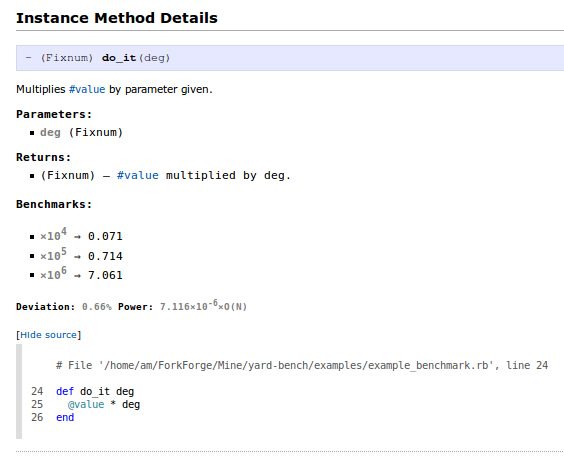
Security News
New Website “Is It Really FOSS?” Tracks Transparency in Open Source Distribution Models
A new site reviews software projects to reveal if they’re truly FOSS, making complex licensing and distribution models easy to understand.
Lazy benchmarking of your project, which appears in the generated YARD documentation. There is a handy DSL provided to make benchmarking almost without additional effort.
To mark a method(s) for benchmarking, just put
benchmark :meth1, :meth2
or
⌚ :meth1, :meth2
or even
benchmark :⋅
somewhere inside your class declaration. The latter states for benchmarking all the instance methods, defined in the class. There are four wildcards available:
:⋅ — benchmark instance methods of a class;:⋅⋅ — benchmark instance methods of a class and all the superclasses;:× — benchmark class methods of a class;:×× — benchmark class methods of a class and all the superclasses;Let’s say there is a class BmExample that you want to benchmark:
# Example module to test benchmarking functionality.
module BmExamples
# Example class to test benchmarking functionality.
class BmExample
benchmark :do_it
⌚ :do_other
# The value
attr_reader :value
# Constructor.
# @param value [Fixnum] the value to add to 10 within {#value} initializer.
# @param addval [Fixnum] another value to add to 10 within {#value} initializer.
# @param attrs [Hash] additional parameters (ignored.)
def initialize value, addval, *attrs
@value = 10 + value + addval
end
# Multiplies {#value} by parameter given.
# @param deg [Fixnum]
# @return [Fixnum] {#value} multiplied by deg.
def do_it deg
@value * deg
end
# Produces a power of the parameter given.
# @param base [Fixnum]
# @return [Fixnum] {#value} in a power of base
def do_other base = 2
@value ** base
end
end
end
The fifth and sixth lines of code will mark methods do_it and do_other for benchmarking.
Actual benchmarking will take place during yard documentation production. This definitely will
slow up the documentation generation, but in the production environment these do not
interfere the normal execution timeline at all.
After the generation is done, the methods are measured with an intellectual algorhytm:

The results are 〈almost〉 independent of the architecture of the target machine on which
the measurements were done (they are normalized by 1_000_000.times {"foo bar baz".capitalize}.)
There are meaningful values for amounts of times to test chosen (three results, having
significant figures in hundredth part.) The algorythm calculates the deviation of results and
suggests O(N) power of function timing, whether possible.
Add this line to your application's Gemfile:
gem 'yard-bench'
And then execute:
$ bundle
Or install it yourself as:
$ gem install yard-bench
Put the following code anywhere within your class:
benchmark :func1, :func2
or even:
class String
⌚ :⋅
and the benchmarks for the chosen functions will be included in yardoc.
git checkout -b my-new-feature)git commit -am 'Add some feature')git push origin my-new-feature)FAQs
Unknown package
We found that yard-bench demonstrated a not healthy version release cadence and project activity because the last version was released a year ago. It has 1 open source maintainer collaborating on the project.
Did you know?

Socket for GitHub automatically highlights issues in each pull request and monitors the health of all your open source dependencies. Discover the contents of your packages and block harmful activity before you install or update your dependencies.

Security News
A new site reviews software projects to reveal if they’re truly FOSS, making complex licensing and distribution models easy to understand.

Security News
Astral unveils pyx, a Python-native package registry in beta, designed to speed installs, enhance security, and integrate deeply with uv.

Security News
The Latio podcast explores how static and runtime reachability help teams prioritize exploitable vulnerabilities and streamline AppSec workflows.